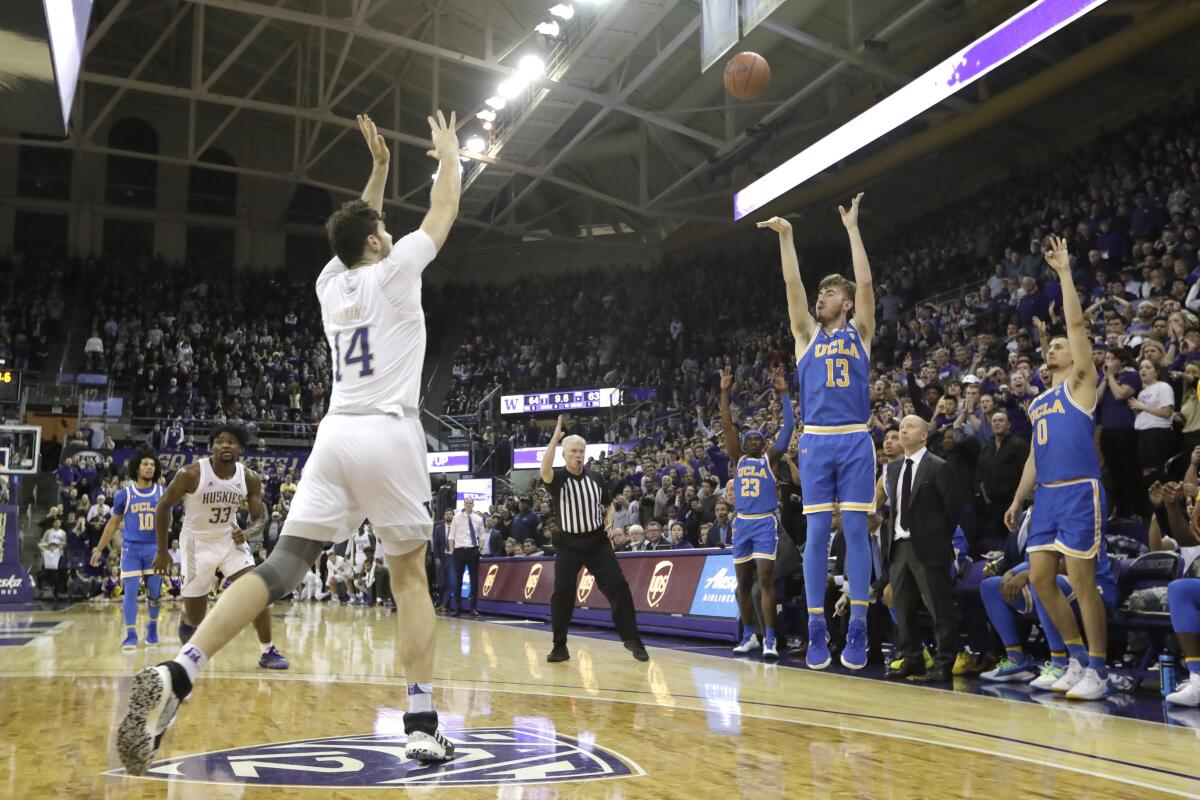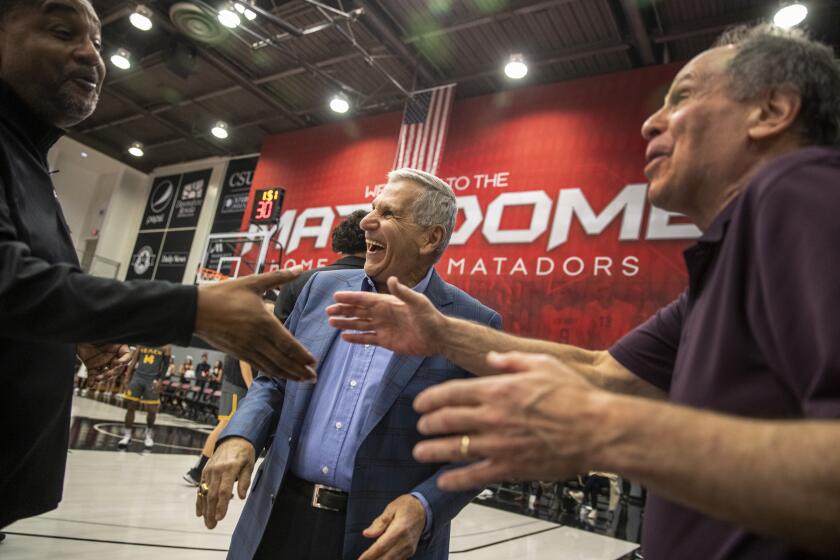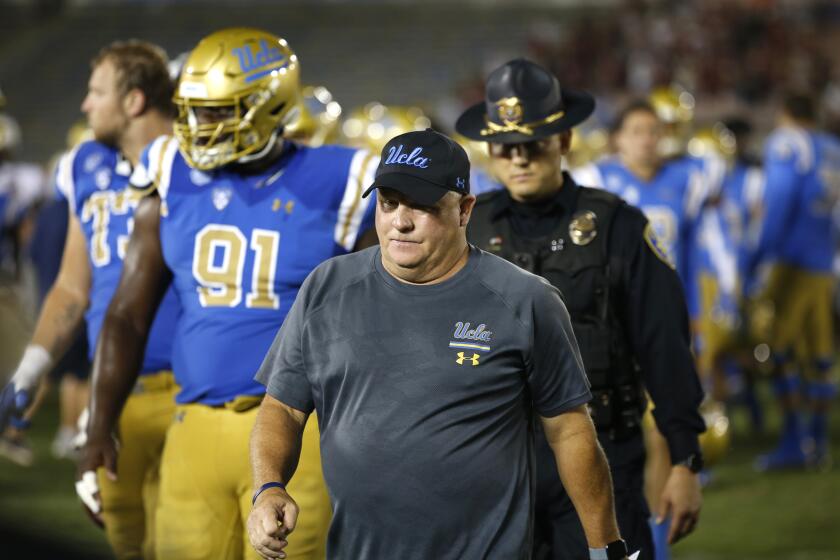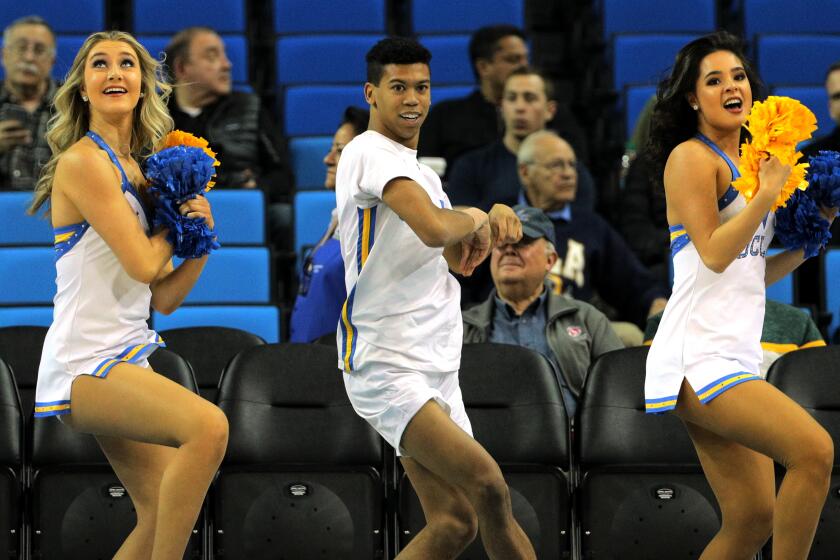UCLA is historically bad from three-point range. Mick Cronin thinks he knows why

- Share via
The highlight from UCLA’s signature victory invariably shows the same sequence. Guard Jake Kyman rises from beyond the three-point line inside Washington’s Alaska Airlines Arena, burying the shot that puts the Bruins ahead in the final seconds.
It’s what came before the shot that most pleased Bruins coach Mick Cronin and partially explains why his team hasn’t had more moments to celebrate this season.
Guard Chris Smith dribbled toward the basket to suck in multiple defenders before throwing a pass to teammate Tyger Campbell, who flung the ball while in midair to Kyman on the wing. It’s the sort of zippy ball movement the Bruins have lacked while being historically bad from long range.
“Guys who can break down the defense and find the open man, that’s the key,” Cronin said Tuesday when asked about his team’s struggles from beyond the arc. “That’s something we’re continuing to work on.”
The Bruins need lots of work based on the numbers. They have made only 30.5% of their three-pointers, putting them on pace to break the school’s previous low of 32.5% during the 2009-10 season.
Jim Harrick led UCLA to a national championship in basketball in 1995, but the scars of a messy split with the school a year later remain.
The three-point line was moved back nearly 1½ feet this season to 22 feet, 1¾ inches, aligning with international rules and leading to a nationwide dip in accuracy. The 350 Division I college teams were collectively making 33.1% of their three-pointers as of Tuesday, according to basketball analyst Ken Pomeroy, down from 34.4% last season and on pace for a record low dating to the adoption of the three-point line for the 1986-87 season.
The increased distance only partially explains UCLA’s percentage, which ranks in a three-way tie for No. 292 nationally alongside Jacksonville and Florida Gulf Coast. Cronin said his team’s issues passing, moving without the ball and creating proper spacing have also contributed to the low percentage.
“Great shooting can mask a lot of weaknesses,” Cronin said, “but I would tell you our problem is passing.”
Cronin said passing is the hardest basketball skill to teach because it’s largely based on a natural feel for the game. That’s why the Bruins run one drill where players must throw a minimum number of passes before anyone can take a shot.
There are a handful of success stories. Kyman is making a team-high 41.9% of his three-pointers and Smith is shooting 33.3% from beyond the arc, up from 28.1% last season and well above the 17.9% he made as a freshman.
But most of the numbers are down. Guard Prince Ali is shooting a career-low 21.3% from long range while guards Jules Bernard (30.8%) and David Singleton (40%) are well off their numbers from last season, though Singleton’s dip could be partially attributed to a lengthy injury layoff after breaking his foot during the Pac-12 tournament. Bernard said poor shot selection was another factor, with players sometimes hoisting difficult shots late in the shot clock.
The UCLA football and men’s basketball teams have been struggling for years, and fans are beginning to lose hope the programs will ever resurrect past glories.
“Obviously we’re not doing the best right now,” Singleton said, “so we’re watching film, learning what we need to do and those are [some] of those things — passing the ball, moving without the ball and not being stagnant on offense.”
Sagging effort
The Bruins (8-8 overall, 1-2 Pac-12) have lost their last two games mostly because of their second-half defense.
They led Washington State by nine points at halftime before the Cougars shot 55.6% in the second half and 66.7% in overtime. They trailed USC by two points at halftime before the Trojans shot 69.6% in the second half.
Cronin said the inability to sustain defensive effort was a function of a young team lacking focus. Bernard indicated that players’ focus could wane within individual possessions.
“We have good initial efforts that maybe cause a bad shot or a loose ball,” Bernard said, “but it’s that second effort to box out and get the rebound or dive on a loose ball. Or even if we play good for the first 15 seconds of the shot clock, sometimes we fall asleep for the last however many seconds on the shot clock.”
Devin Mallory, a third-year dance major, became the first male member of the UCLA dance team this school year.
UP NEXT
VS. STANFORD
When: 7 p.m. Wednesday
Where: Pauley Pavilion.
On the air: TV: Pac-12 Network; Radio: 570.
Update: Stanford (14-2, 3-0) is the only unbeaten team in Pac-12 play mostly because of its defense. The Cardinal are giving up a conference-low 58.3 points per game while holding teams to 38.5% shooting and 30.4% shooting from beyond the arc, offsetting an offense that has generated more turnovers (14.8 per game) than assists (14.1). Junior forward Oscar da Silva leads the team with 16.5 points per game.
More to Read
Go beyond the scoreboard
Get the latest on L.A.'s teams in the daily Sports Report newsletter.
You may occasionally receive promotional content from the Los Angeles Times.










